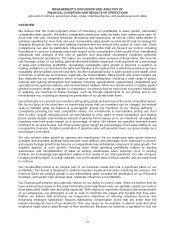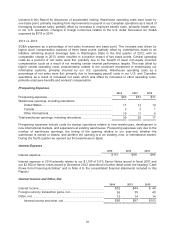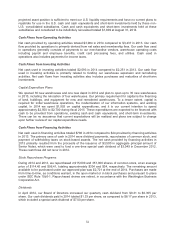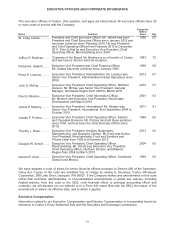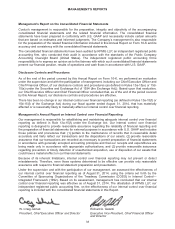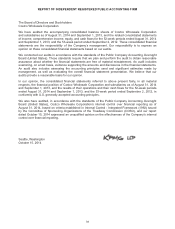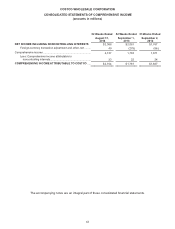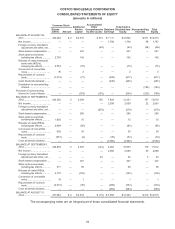Costco 2014 Annual Report Download - page 36
Download and view the complete annual report
Please find page 36 of the 2014 Costco annual report below. You can navigate through the pages in the report by either clicking on the pages listed below, or by using the keyword search tool below to find specific information within the annual report.review our accounting policies and evaluate our estimates, including those related to revenue recognition,
investments, merchandise inventory valuation, impairment of long-lived assets, insurance/self-insurance
liabilities, and income taxes. We base our estimates on historical experience and on assumptions that we
believe to be reasonable. For further information on significant accounting policies, see discussion in Note
1 to the consolidated financial statements included in this Report.
Revenue Recognition
We generally recognize sales, which include shipping fees where applicable, net of returns, at the time
the member takes possession of merchandise or receives services. When we collect payment from
customers prior to the transfer of ownership of merchandise or the performance of services, the amount
received is generally recorded as deferred revenue in the consolidated balance sheets until the sale or
service is completed. We provide for estimated sales returns based on historical trends in merchandise
returns, net of the estimated net realizable value of merchandise inventories to be returned and any
estimated disposition costs. Amounts collected from members that under common trade practices are
referred to as sales taxes are recorded on a net basis.
We evaluate whether it is appropriate to record the gross amount of merchandise sales and related costs
or the net amount earned. Generally, when we are the primary obligor, subject to inventory risk, have
latitude in establishing prices and selecting suppliers, influence product or service specifications, or have
several but not all of these indicators, revenue and related shipping fees are recorded on a gross basis. If
we are not the primary obligor and do not possess other indicators of gross reporting as noted above, we
record the net amounts earned, which is reflected in net sales.
We account for membership fee revenue, net of refunds, on a deferred basis, whereby revenue is
recognized ratably over the one-year membership period. Our Executive members qualify for a 2%
reward on qualified purchases (up to a maximum of approximately $750 per year), which can be
redeemed only at Costco warehouses. We account for this reward as a reduction in sales. The sales
reduction and corresponding liability are computed after giving effect to the estimated impact of non-
redemptions based on historical data.
Investments
Investments are reviewed quarterly for indicators of other-than-temporary impairment. This determination
requires significant judgment. We employ a methodology that considers available quantitative and
qualitative evidence. If the cost of an investment exceeds its fair value, we evaluate, among other factors,
general market conditions, the duration and extent to which the fair value is less than cost, and our intent
and ability to hold the investment. We also consider specific adverse conditions related to the financial
health of and business outlook for the issuer, including industry and sector performance, operational and
financing cash flow factors, and rating agency actions. Once a decline in fair value is determined to be
other-than-temporary, an impairment charge is recorded and a new cost basis in the investment is
established.
Merchandise Inventories
Merchandise inventories are valued at the lower of cost or market, as determined primarily by the retail
inventory method, and are stated using the last-in, first-out (LIFO) method for substantially all U.S.
merchandise inventories. Merchandise inventories for all foreign operations are primarily valued by the
retail inventory method and are stated using the first-in, first-out (FIFO) method. We believe the LIFO
method more fairly presents the results of operations by more closely matching current costs with current
revenues. We record an adjustment each quarter, if necessary, for the estimated effect of inflation or
deflation, and these estimates are adjusted to actual results determined at year-end.
We provide for estimated inventory losses (shrink) between physical inventory counts as a percentage of
net sales. The provision is adjusted periodically to reflect results of the actual physical inventory counts,
which generally occur in the second and fourth quarters of the year.
Inventory cost, where appropriate, is reduced by estimates of vendor rebates when earned or as we
progress toward earning those rebates, provided they are probable and reasonably estimable. Other
34



